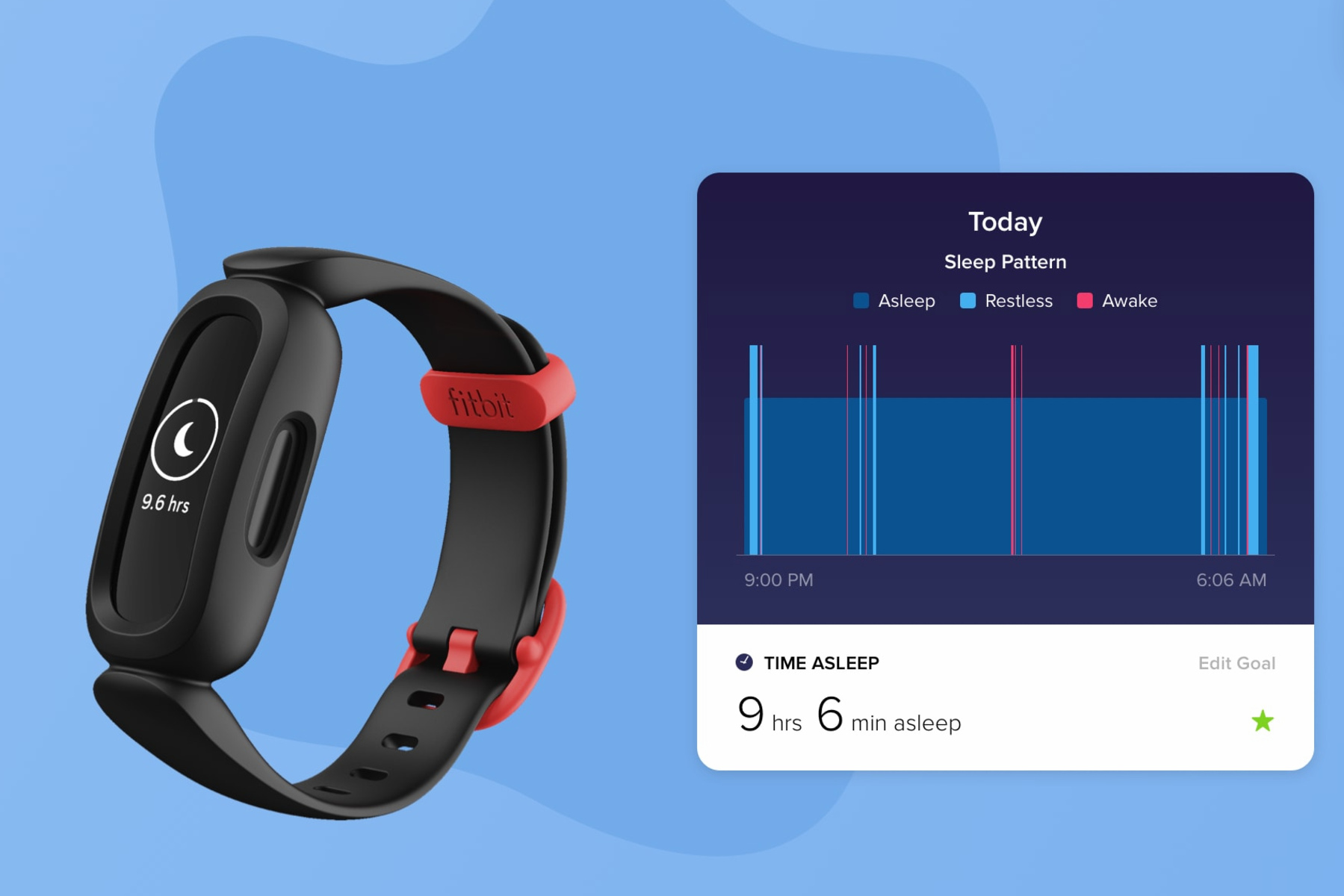Introduction
The quality of our sleep profoundly influences our overall well-being, affecting our physical health, mental acuity, and emotional balance. As we navigate the demands of our daily lives, it's essential to recognize the significance of restful, uninterrupted sleep. However, achieving this can be challenging, especially when we experience restless sleep patterns.
Restless sleep is a common concern for many individuals, characterized by frequent movements, awakenings, or a general sense of discomfort during the night. Understanding the nuances of restless sleep and its impact is crucial for taking proactive steps towards improving our sleep quality.
In this comprehensive guide, we will delve into the intricacies of restless sleep, exploring the factors that contribute to its occurrence and its implications for overall well-being. Furthermore, we will examine how wearable technology, such as Fitbit devices, provides valuable insights into our sleep patterns, empowering us to make informed decisions about our sleep habits.
By gaining a deeper understanding of restless sleep norms and utilizing actionable tips, we can work towards fostering a more restful and rejuvenating sleep experience. Join us as we embark on this journey to unravel the mysteries of restless sleep and discover effective strategies for achieving a more peaceful night's rest.
What is Restless Sleep?
Restless sleep refers to a disrupted sleep pattern characterized by frequent movements, awakenings, or a general sense of discomfort during the night. While occasional restlessness is normal, persistent disruptions can significantly impact the overall quality of sleep. These disturbances can manifest in various forms, including tossing and turning, waking up frequently, or experiencing difficulty in falling back asleep.
Several factors contribute to restless sleep, ranging from lifestyle choices to underlying health conditions. Stress and anxiety often play a pivotal role in disrupting sleep, leading to heightened physiological arousal and difficulty in achieving a state of relaxation conducive to restful sleep. Additionally, environmental factors such as excessive noise, uncomfortable room temperature, or an unsupportive mattress can contribute to restlessness during sleep.
Moreover, certain medical conditions, including sleep disorders like sleep apnea or restless leg syndrome, can significantly disrupt the sleep cycle, leading to restlessness. These conditions often result in fragmented sleep, preventing individuals from attaining the deep, restorative stages of sleep necessary for overall well-being.
The impact of restless sleep extends beyond mere physical discomfort. It can lead to daytime drowsiness, reduced cognitive function, and mood disturbances, affecting one's productivity and emotional equilibrium. Furthermore, chronic restless sleep has been linked to an increased risk of developing various health conditions, including cardiovascular issues, obesity, and compromised immune function.
Understanding the nuances of restless sleep is crucial for identifying potential underlying causes and implementing effective strategies to improve sleep quality. By recognizing the signs of restless sleep and its potential implications, individuals can take proactive steps to address these disturbances and foster a more restful and rejuvenating sleep experience.
Factors Affecting Restless Sleep
Restless sleep can be influenced by a myriad of factors, encompassing both lifestyle and health-related elements. Understanding these influences is crucial for addressing the root causes of restlessness and promoting better sleep quality. Here are the key factors affecting restless sleep:
-
Stress and Anxiety: Psychological factors, such as stress and anxiety, can significantly disrupt the ability to attain restful sleep. Heightened levels of stress trigger the release of cortisol, a hormone associated with increased alertness and arousal, making it challenging to achieve a state of relaxation conducive to sleep. Persistent worries and anxious thoughts can lead to fragmented sleep, with individuals experiencing frequent awakenings throughout the night.
-
Environmental Disruptions: The sleep environment plays a pivotal role in determining the quality of sleep. Disruptions such as excessive noise, bright lights, uncomfortable room temperature, or an unsupportive mattress can contribute to restlessness during sleep. Creating a tranquil sleep environment by minimizing disruptive elements can significantly enhance the ability to achieve restful sleep.
-
Lifestyle Choices: Certain lifestyle habits, including irregular sleep schedules, excessive caffeine consumption, and late-night screen exposure, can disrupt the natural sleep-wake cycle, leading to restlessness during sleep. Additionally, consuming heavy meals close to bedtime or engaging in stimulating activities before sleep can hinder the ability to achieve deep, restorative sleep.
-
Physical Discomfort: Unaddressed physical discomfort, such as chronic pain, restless leg syndrome, or discomfort from an unsupportive sleep surface, can contribute to restlessness during sleep. Individuals experiencing discomfort may frequently shift positions or awaken throughout the night, preventing them from entering the restorative stages of sleep.
-
Medical Conditions: Underlying medical conditions, including sleep disorders like sleep apnea, insomnia, or mental health disorders, can significantly disrupt the sleep cycle, leading to persistent restlessness. Identifying and addressing these conditions is essential for improving sleep quality and overall well-being.
By recognizing and addressing these factors, individuals can take proactive steps to mitigate the impact of restless sleep and foster a more restful and rejuvenating sleep experience. Implementing lifestyle modifications, creating a conducive sleep environment, and seeking appropriate medical intervention can significantly improve sleep quality, enhancing overall health and vitality.
Fitbit Restless Sleep Data
Fitbit, a leading provider of wearable technology, offers valuable insights into individuals' sleep patterns through its innovative sleep tracking features. By utilizing advanced sensors and algorithms, Fitbit devices meticulously monitor various aspects of sleep, including periods of restlessness, awakenings, and overall sleep duration. This data provides users with a comprehensive overview of their sleep quality, empowering them to make informed decisions about their sleep habits and overall well-being.
The Fitbit sleep tracking feature captures data on periods of restlessness during the night, shedding light on the frequency and duration of movements or awakenings. This information is presented in a user-friendly format, allowing individuals to visualize their sleep patterns and identify potential areas for improvement. By leveraging this data, users can gain insights into their restless sleep tendencies, enabling them to take proactive measures to enhance sleep quality.
Furthermore, Fitbit devices offer detailed analyses of sleep stages, distinguishing between light, deep, and REM (rapid eye movement) sleep. By correlating periods of restlessness with specific sleep stages, users can gain a deeper understanding of how restlessness impacts the overall structure of their sleep. This nuanced approach to sleep tracking enables individuals to discern patterns and trends, facilitating targeted interventions to mitigate restlessness and optimize sleep quality.
The integration of Fitbit's restless sleep data with other health metrics, such as physical activity levels, heart rate variability, and stress management scores, provides a holistic perspective on the factors influencing sleep quality. This comprehensive approach allows users to identify potential correlations between lifestyle choices, stress levels, and restless sleep patterns, fostering a more nuanced understanding of their overall well-being.
By harnessing Fitbit's restless sleep data, individuals can embark on a journey towards improved sleep quality and enhanced vitality. Armed with actionable insights, users can implement personalized strategies to address restlessness during sleep, such as optimizing their sleep environment, practicing relaxation techniques, and establishing consistent bedtime routines. Ultimately, the integration of Fitbit's restless sleep data into individuals' wellness journeys empowers them to prioritize restful sleep and cultivate a healthier, more balanced lifestyle.
Utilizing Fitbit's restless sleep data as a catalyst for positive change, individuals can embark on a transformative path towards achieving optimal sleep quality and overall well-being. With the ability to track, analyze, and act upon restless sleep patterns, individuals can unlock the potential for profound improvements in their sleep habits, ultimately enhancing their physical, mental, and emotional vitality.
Understanding Normal Restless Sleep Patterns
Normal restless sleep patterns encompass occasional movements and brief awakenings during the night, which are inherent to the natural sleep cycle. These intermittent disturbances are part of the body's regulatory mechanisms and do not significantly disrupt the overall quality of sleep. It is essential to recognize that experiencing occasional restlessness is a normal physiological response and does not necessarily indicate underlying sleep disturbances.
Fitbit's sleep tracking data provides valuable insights into discerning normal restless sleep patterns from more disruptive forms of restlessness. By analyzing the frequency and duration of movements and awakenings, individuals can gain a comprehensive understanding of their typical sleep patterns. This data enables users to differentiate between sporadic, inconsequential movements and prolonged, disruptive restlessness, allowing for a nuanced interpretation of their sleep quality.
Moreover, understanding normal restless sleep patterns involves recognizing the cyclical nature of sleep stages and the associated movements and awakenings. The sleep cycle comprises distinct stages, including light sleep, deep sleep, and REM sleep, each characterized by varying levels of physical and mental activity. It is natural for individuals to experience fluctuations in restlessness across these sleep stages, reflecting the body's transitions between different states of consciousness.
By leveraging Fitbit's detailed sleep stage analyses, individuals can identify the typical distribution of restlessness throughout the night, gaining insights into how their movements align with different sleep stages. This holistic perspective fosters a deeper comprehension of normal restless sleep patterns, allowing individuals to contextualize their sleep data within the framework of healthy sleep physiology.
Furthermore, understanding normal restless sleep patterns involves considering individual variations in sleep behavior and preferences. Factors such as age, lifestyle, and overall health can influence an individual's typical sleep patterns, including the frequency and intensity of restlessness. By acknowledging these variations, individuals can develop a personalized understanding of what constitutes normal restless sleep for them, empowering them to set realistic expectations and goals for optimizing their sleep quality.
In essence, understanding normal restless sleep patterns encompasses a multifaceted approach that integrates objective sleep tracking data, awareness of sleep stage dynamics, and recognition of individual differences. By embracing this comprehensive understanding, individuals can cultivate a balanced perspective on their sleep quality, fostering a proactive and informed approach to addressing restlessness and enhancing overall well-being.
Tips for Improving Restless Sleep
Improving restless sleep involves a multifaceted approach that encompasses lifestyle modifications, environmental adjustments, and proactive sleep hygiene practices. By implementing targeted strategies, individuals can address the underlying factors contributing to restlessness and cultivate a more conducive sleep environment. Here are actionable tips for improving restless sleep:
-
Establish a Consistent Sleep Schedule: Prioritize regular sleep and wake times to regulate the body's internal clock, promoting a consistent sleep-wake cycle. By adhering to a set schedule, individuals can optimize their circadian rhythms, reducing the likelihood of restlessness during sleep.
-
Create a Tranquil Sleep Environment: Minimize environmental disruptions by ensuring a quiet, dark, and comfortable sleep space. Implementing blackout curtains, white noise machines, or earplugs can mitigate disturbances, fostering a serene setting conducive to restful sleep.
-
Practice Relaxation Techniques: Engage in relaxation practices, such as deep breathing exercises, meditation, or gentle stretching before bedtime. These techniques promote relaxation, alleviate stress, and prepare the body for a restful night's sleep, reducing the propensity for restlessness.
-
Limit Stimulating Activities Before Bed: Avoid stimulating activities, such as intense exercise, excessive screen time, or consuming caffeinated beverages close to bedtime. Opt for calming activities, such as reading or listening to soothing music, to wind down and signal the body for sleep.
-
Optimize Sleep Surface and Bedding: Invest in a supportive mattress and comfortable bedding to minimize physical discomfort during sleep. Proper spinal alignment and pressure relief can reduce the likelihood of frequent movements and awakenings, enhancing overall sleep quality.
-
Manage Stress and Anxiety: Incorporate stress-reducing practices into daily routines, such as mindfulness, journaling, or seeking professional support. Managing stress and anxiety can alleviate hyperarousal, promoting a more relaxed state conducive to restful sleep.
-
Evaluate Dietary Choices: Be mindful of dietary factors that can impact sleep, such as heavy meals, excessive alcohol consumption, or consuming stimulating foods close to bedtime. Opt for light, balanced meals and hydrate adequately throughout the day to support optimal sleep quality.
-
Utilize Sleep-Friendly Technology: Leverage sleep tracking features on wearable devices, such as Fitbit, to monitor restless sleep patterns and identify areas for improvement. By integrating technology into sleep management, individuals can gain valuable insights and track progress towards better sleep quality.
By integrating these tips into their daily routines, individuals can proactively address restless sleep and cultivate a more conducive sleep environment. Embracing a holistic approach to sleep improvement empowers individuals to take charge of their sleep quality, fostering a renewed sense of vitality and well-being.
Conclusion
In conclusion, understanding and addressing restless sleep is essential for nurturing overall well-being and vitality. By delving into the intricacies of restless sleep and its impact, individuals can gain valuable insights into their sleep patterns and take proactive steps towards enhancing sleep quality. Fitbit's innovative sleep tracking features provide a comprehensive understanding of restless sleep patterns, empowering users to make informed decisions about their sleep habits and overall health.
The multifaceted nature of restless sleep, influenced by factors such as stress, environmental disruptions, lifestyle choices, physical discomfort, and underlying health conditions, underscores the importance of a holistic approach to sleep improvement. By recognizing the nuanced interplay of these factors, individuals can implement targeted strategies to address restlessness and foster a more conducive sleep environment.
Moreover, the integration of Fitbit's restless sleep data with other health metrics offers a holistic perspective on sleep quality, enabling users to identify potential correlations between lifestyle choices, stress levels, and restless sleep patterns. This comprehensive approach facilitates a nuanced understanding of overall well-being and empowers individuals to prioritize restful sleep as a cornerstone of a healthy lifestyle.
The actionable tips for improving restless sleep, encompassing sleep schedule consistency, relaxation techniques, environmental adjustments, and stress management, provide a practical framework for individuals to proactively address restlessness and optimize sleep quality. By embracing these strategies, individuals can embark on a transformative journey towards achieving restful sleep and revitalizing their physical, mental, and emotional well-being.
Ultimately, the journey towards improving restless sleep is a personalized and empowering endeavor, guided by insights derived from sleep tracking data, awareness of normal restless sleep patterns, and the implementation of targeted sleep improvement strategies. By leveraging these resources and embracing a proactive approach, individuals can unlock the potential for profound improvements in their sleep habits, ultimately enhancing their overall vitality and quality of life.






















